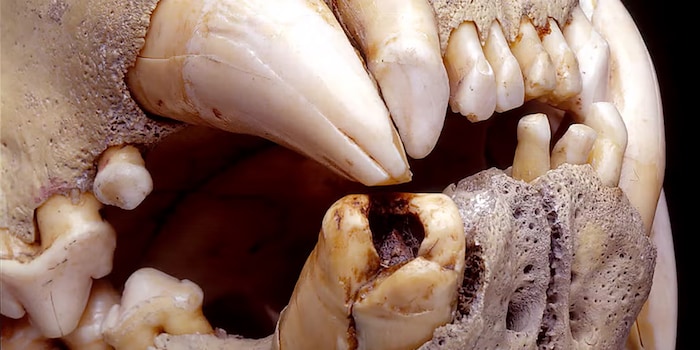
Hair between teeth reveals man-eaters
Even lions get dental problems as they age. The hair that accumulates in the tooth holes provides valuable information about their favourite prey in earlier times.
A notorious pair of lions made the Tsavo region in Kenya unsafe in the 1890s: at least 70 people died at the hands of the two big cats, even though only one of the two animals fed mainly on Homo sapiens. The horror only ended in 1898 when the lions were shot. However, they were not solely focussed on humans, as they preyed on a whole range of different mammals, as Ripan Malhi from the University of Illinois Urbana-Champaign and his team write in a study.
The research group wanted to test how well DNA can be extracted and analysed from individual hair remnants and chose fur remnants from the teeth of Tsavo lions, the remains of which are stored in the Field Museum of Natural History in Chicago. The purpose of the case study was to reconstruct the diet of early big cats in order to compare it with that of modern animals. This could provide conclusions about the changes in ecosystems before they were systematically recorded, write Malhi and co.
The hair remnants were found, for example, between the teeth and in holes that had formed in the teeth over time. For example, one of the large canine teeth of one of the lions broke off; many different hairs were found in its cavity. DNA analysis revealed that the two big cats preyed on a wide range of mammals: Giraffes, oryx antelopes, waterbucks, wildebeests and other lions were also detected. Male lions even kill and eat offspring of their own species if they are not the producers.
The giraffe was identified down to the subspecies level of the Masai giraffe (Giraffa tippelskirchi). The biologists were most surprised by the detection of wildebeest hair. At that time, the species was either more widespread in Tsavo or the lions had a larger radius of action than previously assumed: Today, the nearest occurrence of wildebeest is more than 80 kilometres away from the known territory of the Tsavo man-eaters.
Next, the research group wants to look at how the prey of the two lions changed over time: ultimately, the hair was deposited in layers in the tooth holes. Predators often kill relatively easy human prey when they age or develop dental problems. This could also have been the case with the Tsavo lions.
Spectrum of Science
We are partners of Spektrum der Wissenschaft and want to make well-founded information more accessible to you. Follow Spektrum der Wissenschaft if you like the articles.
Original article on Spektrum.deExperts from science and research report on the latest findings in their fields – competent, authentic and comprehensible.